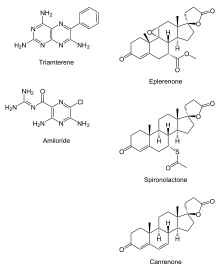Potassium-sparing diuretic
Potassium-sparing diuretics are diuretic drugs that do not promote the secretion of potassium into the urine.[1]

They are used as adjunctive therapy, together with other drugs, in the treatment of hypertension and management of congestive heart failure. However, at low doses the use of potassium-sparing diuretics has not been found to produce a clinically significant reduction in blood pressure.[2]
Medical uses
Potassium-sparing diuretics are generally used in combination with other diuretic drugs (e.g. loop diuretics) that would otherwise tend to decrease the potassium levels to potentially dangerous low levels (hypokalemia). The combination therefore helps maintain a normal reference range for potassium.
Adverse effects
On their own this group of drugs may raise potassium levels beyond the normal range, termed hyperkalemia, which risks potentially fatal arrhythmias.
Mechanism of action
The potassium-sparing diuretics are competitive antagonists that either compete with aldosterone for intracellular cytoplasmic receptor sites, or directly block sodium channels (specifically epithelial sodium channels (ENaC) by amiloride). The former prevents the production of proteins that are normally synthesized in reaction to aldosterone. These mediator proteins are not produced, and so stimulation of sodium-potassium exchange sites in the collection tubule does not occur. This prevents sodium re-absorption and potassium and hydrogen ion secretion in the late distal tubule and collecting duct of a nephron in the kidneys.[3]
Chemical structure
Potassium-sparing diuretics do not share any obvious chemical similarities, except for the steroid-structure of the aldosterone antagonists. Those in clinical use include:
Other diuretics
While not classically considered potassium-sparing diuretics, ACE inhibitors (ACEi) and angiotensin receptor blockers (ARB) are anti-hypertensive drugs with diuretic effects that decrease renal excretion of potassium.[4] They work by inhibiting either the production (ACEis) or effects (ARBs) of angiotensin 2. This results in a decrease in aldosterone release, which causes potassium-sparing-diuretic-like effects similar to those of the aldosterone antagonists, spironolactone and eplerenone.
See also
References
- "diuretic" at Dorland's Medical Dictionary
- Heran BS, Chen JM, Wang JJ, Wright JM (14 November 2012). "Blood pressure lowering efficacy of potassium-sparing diuretics (that block the epithelial sodium channel) for primary hypertension". Cochrane Database of Systematic Reviews (11). doi:10.1002/14651858.cd008167.pub3. ISSN 1465-1858.
- Pharmacology. 2nd ed. Harvey, Champe.
- "ACE Inhibitors; ARBS/Potassium Sparing Diuretics". Drug-Drug Interaction. JIRDC. Retrieved 17 March 2012.
External links
- Potassium+Sparing+Diuretics at the US National Library of Medicine Medical Subject Headings (MeSH)